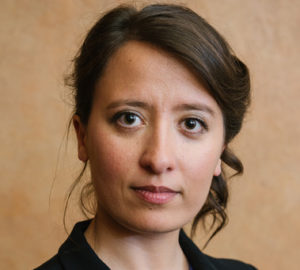
Elizaveta Gaufman is Assistant Professor of Russian Discourse and Politics at the University of Groningen, Netherlands.
Why did Russia start the full-scale invasion of Ukraine on 24 February 2022? If you examine the numerous statements released by the Russian government and pro-Kremlin media, there are many reasons to choose from, from biological laboratories that are supposed to infect birds with diseases that can spread among the Russian population, to NATO, to the tried-and-tested narrative about “Ukrainian Nazis.” However, recently a new reason was put forward by the Russian government: “de-satanification” of Ukraine. It seems that the Kremlin can no longer persuade the population to fight against Banderovites (the name Russian propaganda uses for the Ukrainian military), and they decided to resort to a much more comprehensive enemy image—the Devil. As a scholar of enemy images, I argue this turn in Kremlin rhetoric shows that the Russian government has exhausted all possible ways to deride Ukrainians and is going for the metaphysical jugular. While it is a staple method in propaganda, this strategy is going to fail for a number of reasons, including very low religiosity levels in Russia. However, it is important to take a look at the enmification mechanism altogether.
First, let’s walk through the various stages. Creating an enemy is difficult, and it takes time and a significant propaganda effort that culminates in dehumanization; after all, it’s much easier to get people to kill others if they are not people but are instead insects, cockroaches or snakes, or other animals one can find in fascist rhetoric. Initially, existing negative preconceptions (for example, in the form of prejudice) should circulate in society. The next step to creating an enemy image is generalization—a usual method in identity construction to denote the group of “us” versus “them” or to create an in-group and out-group. Next follows differentiation or othering—also a crucial step in identity construction that shows what set of qualities makes us different from them. Then the difference becomes negative, usually in the form of old prejudices wrapped around the difference and generalization with a derisive overtone. The final step is a full-blown enemy image that involves a threat and dehumanization. For a more compelling enemy image, a visual representation would also be useful, for instance, having several faces or being ugly, which is the most common association with evil.
How does that work in the case of Ukraine? There has always been some anti-Ukrainian prejudice in mainstream Russian culture—representing Ukrainians as backward peasants or noble savages, for example. Generalizing this prejudice was often a matter of state policy in the Soviet Union, for instance, through economic policies that prioritized specific economic activities in “national republics”: Ukraine having the “breadbasket” or heavy industry function gives it a certain generalizable class characteristic that could be ranked and ordered in a neat (racialized) hierarchy with the “great Russian people,” according to Stalin, at the helm.
Differentiation or othering can be both positive or negative, but in most cases the othering process reproduces pre-existing ethnic divisions and, in the end, enables securitization by representing the out-group as threatening to the in-group—through physical danger, criminal activities, or alien cultural influences. In the case of Ukrainians, the othering process was carried out primarily through “alien cultural influences”. Many Russian politicians even deny the existence of Ukraine and Ukrainians, only identifying Ukrainians as a subset of Russians with Polish influences, misled by the “false ideology” of the existence of the Ukrainian nation and culture.
I would argue that the Ukrainian enemy image became full-blown around the Euromaidan protests against Viktor Ynukovych’s regime in winter of 2013–14. Russia’s subsequent annexation of Crimea was accompanied by constant infusion of existing anti-Ukrainian prejudice with the existential threat of Nazism in the state-controlled media. However, given the abrupt full-scale invasion on 24 February 2022, pro-Kremlin media were struggling to maintain a full-blown enemy image, hence the attempts at bringing together multiple threats from birds to poisoned soda, or, as Paul Goode calls it, the “spaghetti on the wall” technique of employing every possible justification.
Where does Satan factor in here? In my opinion, it’s a last-ditch attempt by the Kremlin to solidify the Ukrainian-as-enemy image among the Russian population. If in 2014 the Kremlin relied mostly on the fascism narrative in order to personify the existential threat, in 2022 it does not seem to have the same mobilizing effect among the majority of the population. Moreover, the scale of draft evasion in Russia shows that the final stage of enemy construction, where dehumanization reaches the level of willing to kill the Other, is relatively limited; the fact that it is present at all is horrendous. There is evidence of pro-Kremlin actors employing religion-based narratives as early as 2013, but in 2022, Patriarch Kirill is openly talking about dying for Russian ideology, with Russian soldiers waging the war against Ukrainians supposedly receiving absolution for their sins. Moreover, the Patriarch has become the main conduit of “spiritual” justification of the war, apart from Chechnya’s Ramzan Kadyrov discussing the war against Ukraine in terms of jihad and calling Ukrainians shaitans (devils).
In many ways, the religious framing of the war against Ukraine has been a long time coming, with Putin trying to fashion himself as a new Volodymyr the Great (or Volodymyr the Baptizer in church history) and discussing the transcendent nature of the so-called “Russian world.” Social media data does show reliance on so-called traditional values in Russian propaganda and disinformation, but there is little evidence that the Russian population would accept a supernatural framing. Even those who support the war would often embrace a Soviet-era repackaged discourse about NATO encroachment or an imperial version of the “friendship of the peoples” discourse where the “Ukrainian brothers” are supposed to stick with Russia. Even though the Kremlin has tried to inject metaphysical justifications for anti-Ukrainian sentiment and war for a while, the population sticks with the narrative devil they know.
